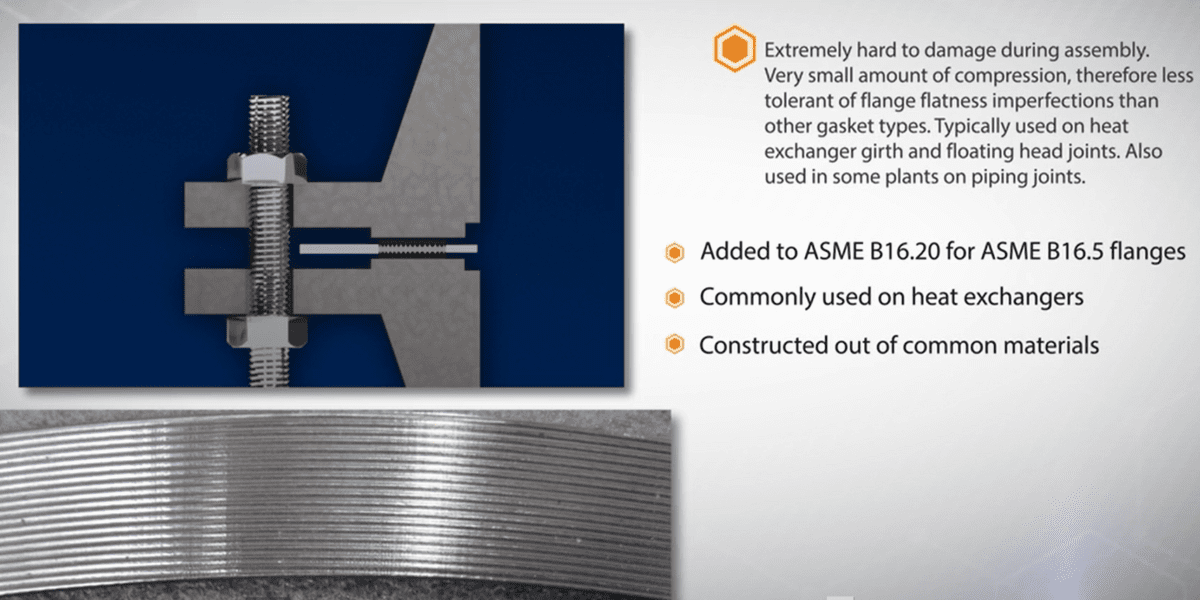Kammprofile Gaskets (also known as grooved metal gaskets or spelled as camprofile gaskets) are our best friends in the heat exchanger world due to their durability. We are going deeper into what they are and answering, “What is a Kammprofile Gasket, and why do we care?”
- Kammprofile, aka Grooved Metal Gasket, Camprofile
- Strengths of a Kammprofile Gasket
- Weaknesses of Kammprofile Gaskets
- Kammprofile vs. Spiral-Wound gaskets on Flanges
Kammprofile, aka Grooved Metal Gasket, Camprofile
The kammprofile gasket is made of a solid metal core that can be made with regular gasket materials. These materials are carbon steel, 304 stainless steel, 316 stainless steel (if you need to go to higher temperatures), and other high-temperature materials such as Hastelloy and Inconel.
The gasket manufacturer will machine serrations that look like grooves into the gasket material; that’s where we get the term grooved metal gasket from. These serrations are made to put a facing material on the sealing surface.
The facing material (filler material) is often typically a soft facing material such as graphite facing (flexible graphite is what manufacturers call it). Other non-asbestos fillers include mica (high-temperature applications), PTFE, and other sealing materials.
While they don’t need a guide ring (like the outer ring of a spiral wound gasket), we like to see them on the gasket as it helps the assembler center the gasket during assembly. This can be adapted to this gasket, but we only see the graphite facing in petrochemical applications.
- NOTE: the guide ring will be loose-fitting, which is a good thing! It allows the solid metal core of the gasket to grow during thermal expansion!
Items not covered in this article: o-rings, compression packing.
Strengths of a Kammprofile Gasket
Kammprofile gaskets (or camprofile gaskets) are our best friends for heat exchangers and other custom flanges. Kammprofiles are tough, hard to destroy in assembly, they work in high temperatures, they work at high pressures, and they can take large bolt loads.
They are way better than double jacketed gaskets, better than corrugated metal gaskets, and large diameter (B16.47 piping or greater than 24″ flanges) spiral wound gaskets.
- NOTE: Large diameter spiral wound gaskets want to buckle and pop out. In contrast, small amounts of graphite pop up on Kammprofile gaskets.
Kammprofile gaskets are also super resilient to radial sheer, which we discussed in our training and other articles.
Probably the best part of these gaskets is how easy it is to adjust the area of the gasket to generate a better seal.
Kammprofiles may be put into many different configurations of flanges, such as flat face flanges and even muffler joints found in vehicles!
Some manufacturers even offer conversion gaskets for ring joint gaskets to raised face flanges.
Weaknesses of Kammprofile Gaskets
A drawback of these gaskets is that they are hard and are more susceptible to imperfections in the flange face.
So we need to make sure that our flange sealing surface has minimal dents and scratches and make sure that it’s compliant with PCC-1 Appendix D for flatness tolerances for flange surfaces.
Kammprofile vs. Spiral-Wound Gaskets on Flanges
I have two favorite types of gaskets: Kammprofile and Spiral Wound Gaskets. So, where do you put each of them?
Kammprofile’s are incredible for exchangers, but we are hesitant to put these gaskets in smaller raised face flanges (ASME B16.5 flanges)! While Kammprofiles are technically listed in B16.20 dimensions, they have glaring weaknesses in other applications due to their dependence on a near-perfect flange face and inability to recover.
Spiral wound gaskets are WAY more flexible and forgiving to piping flanges flange surfaces.
Then, the question has to be asked, “Why do we have some manufacturers put them into critical piping flanges?”
The answer to that is because when you have a critical system (which typically has excellent QA/QC and procedures), if there isn’t high temperature or thermocycling, we are putting them in a gasket’s heaven! So they should work since we have taken all the bad stuff out of the equation. If you want a robust, suitable gasket for piping flanges, use a spiral wound gasket!! To add to this, if you have metal jacketed gaskets, get a kammprofile gasket, and it will help give you a high-quality seal!
For more thoughts, questions, or concerns about anything in this article, please contact us at [email protected].
See also:


